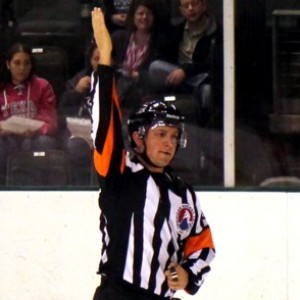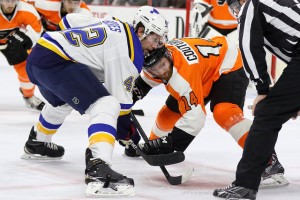In Monday night’s matchup between the Dallas Stars and the Minnesota Wild, Stars winger Antoine Roussel notched what would become the game-winning tally early in the third frame.
The play was clearly onside, both on the original entry and on defenseman Johnny Oduya’s keep at the blue line just before Roussel’s backhand score.
However, despite the lack of any indication that the play was offside, Wild head coach Mike Yeo used his coach’s challenge (and subsequently his timeout) to ask the referees to review the play for a possible infraction.
Here’s the play in question, including Oduya’s keep:
It was immediately obvious that Yeo had chosen to employ a tactic already becoming increasingly popular among NHL coaches; spending their coach’s challenge in order to give their team what amounts to a longer timeout.
It makes perfect sense, really; the coach, knowing full well that he has no chance at overturning the call, chooses to challenge the call anyway. The break likely lasts longer than a traditional timeout, and the game (and possibly the opponent’s momentum) is halted, just as it would be if the coach had decided to spend his one allotted stoppage.
The puck is dropped from center ice, and play continues as if nothing happened. The challenging team puts on its best “aw, shucks” face, the scoring team suppresses its annoyance (partly out of an inability to do anything about the move and partly in case they need to pull the same maneuver), and no one is any worse for wear, right?
In Need of Reform
Wrong. While the challenge has certainly helped referees get calls right and has shown the potential to be a positive part of the league moving forward, this loophole needs to be closed. While not as immediately impactful, the strategy is in the same vein as a jello-legged defenseman throwing the puck the length of the ice to escape pressure. Coaches are able to give their team, which often has just given up a crucial goal in a close game, an extra few minutes to catch its breath and regroup. This isn’t the spirit of the new system; it’s set up to ensure officials get the call right, not to allow for extended timeouts when one team has the upper hand.
So, how do we do it? Obviously, this change is easier said than done. It’s impractical to leave the refs with any sort of subjective power at the beginning of the process regarding whether a coach is employing this tactic out of actual suspicion of an infraction or as a timeout, so altering the genesis of a coach’s challenge is all but out.
That leaves the end of the process. As of now, a coach’s only reprimand for a failed challenge is the loss of their timeout. Due to the solitary nature of coach-ordered breathers, this sounds like an adequate punishment on paper. However, when the game has reached its closing act and a coach has every intention of using his only timeout regardless, this penalty carries no weight.
In order to fix this issue, let’s take a look at two possible solutions:
Solution No. 1: Straight to a Minor Penalty

This solution, which was last proposed by Stars’ color man Daryl Reaugh in the aftermath of the Roussel goal, is cut-and-dry.
If a coach loses a challenge, a delay of game penalty will be assessed to his team, and the scoring team will be placed back on the power play with a full two minutes on the clock. As is the case now, the coach will also lose their traditional timeout.
While this solution would certainly discourage the use of any challenge in which the coach and his assistants felt they had no chance to overturn the play, it comes across at first blush as too heavy-handed. The goal of reform would be to cut down on the use of the loophole, not scare coaches to the point where they may refuse to challenge except in the most blatant of circumstances.
We need something more moderate, at least in the early stages of challenge reform: something in the middle ground that applies the appropriate pressure to coaching staffs to challenge the right kinds of plays but isn’t so totalitarian or lopsided in its application.
Solution No. 2: Treat it like Icing
This solution, devised in order to make losing a challenge carry with it a daunting punishment without jumping straight into making it an infraction, is simple. When a coach loses a challenge, the following play will be conducted as if the challenging team had iced the puck.
In the event of a lost challenge, instead of taking the faceoff at center ice following the goal, the draw will be moved inside the challenging team’s defensive zone. The same five players that were on the ice at the time of the goal will be required to be on the ice at the resumption of play.

In addition, the challenging coach will also not be allowed any contact with the players required to be on the ice when play resumes. They will be instructed to stay on the ice away from their bench so that coaches cannot use the time during review to speak to the players that would have immediately had to resume play in the event of a traditional icing. If a coach is caught interacting with any of these players, a bench minor will be assessed.
If the challenging team was short-handed at the time of the goal being reviewed, the coach will have only the length of a traditional timeout to send out any additional players required to fill out their lineup.
Finally, the coach will still lose their traditional timeout.
Under these rules, coaches would be forced to think long and hard about challenging a goal, but wouldn’t be strong-armed into staying silent in all but the most blatant of circumstances. It’s a balance between the unrestrained nature of the current system and the uber-strict reality of an immediate minor penalty, and would provide the scoring team with an immediate advantage without coming down quite so hard on the challenging club.
Hockey, and the world of sports in general, is full of gamesmanship. The competitive athlete and coach will never shy away from using borderline tactics to gain an advantage, and this new coach’s challenge loophole is no exception. While it’s difficult to blame the coaches, something needs to be done in order to curb the widespread use of the strategy and refine the system in a way that moves it closer to achieving its intended purpose in the majority of cases.